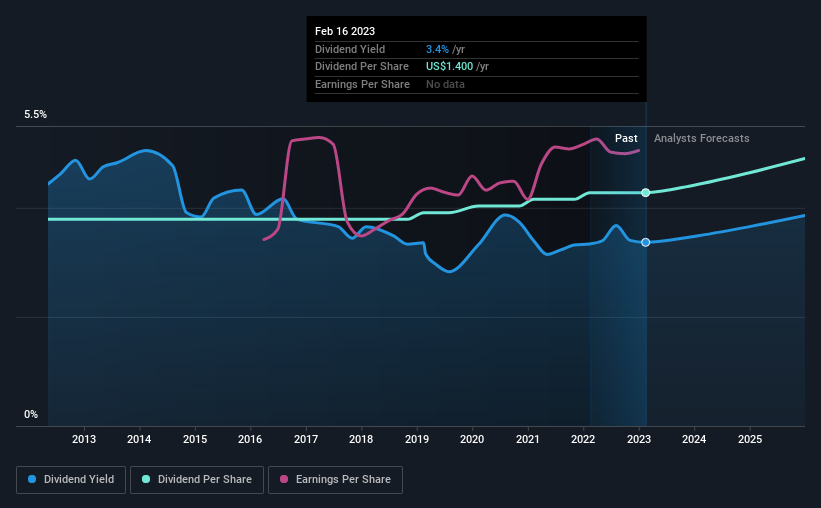- United States
- /
- Electric Utilities
- /
- NYSE:HE
Hawaiian Electric Industries (NYSE:HE) Will Pay A Larger Dividend Than Last Year At $0.36

The board of Hawaiian Electric Industries, Inc. (NYSE:HE) has announced that the dividend on 10th of March will be increased to $0.36, which will be 2.9% higher than last year's payment of $0.35 which covered the same period. This makes the dividend yield about the same as the industry average at 3.4%.
See our latest analysis for Hawaiian Electric Industries
Hawaiian Electric Industries' Dividend Is Well Covered By Earnings
While it is always good to see a solid dividend yield, we should also consider whether the payment is feasible. Prior to this announcement, Hawaiian Electric Industries' earnings easily covered the dividend, but free cash flows were negative. Since a dividend means the company is paying out cash to investors, this could prove to be a problem in the future.
Looking forward, earnings per share is forecast to rise by 16.8% over the next year. If the dividend continues along recent trends, we estimate the payout ratio will be 56%, which is in the range that makes us comfortable with the sustainability of the dividend.

Hawaiian Electric Industries Has A Solid Track Record
Even over a long history of paying dividends, the company's distributions have been remarkably stable. The annual payment during the last 10 years was $1.24 in 2013, and the most recent fiscal year payment was $1.40. This means that it has been growing its distributions at 1.2% per annum over that time. Although we can't deny that the dividend has been remarkably stable in the past, the growth has been pretty muted.
We Could See Hawaiian Electric Industries' Dividend Growing
The company's investors will be pleased to have been receiving dividend income for some time. Hawaiian Electric Industries has impressed us by growing EPS at 7.7% per year over the past five years. The lack of cash flows does make us a bit cautious though, especially when it comes to the future of the dividend.
Our Thoughts On Hawaiian Electric Industries' Dividend
Overall, we always like to see the dividend being raised, but we don't think Hawaiian Electric Industries will make a great income stock. While Hawaiian Electric Industries is earning enough to cover the payments, the cash flows are lacking. We don't think Hawaiian Electric Industries is a great stock to add to your portfolio if income is your focus.
It's important to note that companies having a consistent dividend policy will generate greater investor confidence than those having an erratic one. At the same time, there are other factors our readers should be conscious of before pouring capital into a stock. Case in point: We've spotted 2 warning signs for Hawaiian Electric Industries (of which 1 is potentially serious!) you should know about. Is Hawaiian Electric Industries not quite the opportunity you were looking for? Why not check out our selection of top dividend stocks.
Valuation is complex, but we're here to simplify it.
Discover if Hawaiian Electric Industries might be undervalued or overvalued with our detailed analysis, featuring fair value estimates, potential risks, dividends, insider trades, and its financial condition.
Access Free AnalysisHave feedback on this article? Concerned about the content? Get in touch with us directly. Alternatively, email editorial-team (at) simplywallst.com.
This article by Simply Wall St is general in nature. We provide commentary based on historical data and analyst forecasts only using an unbiased methodology and our articles are not intended to be financial advice. It does not constitute a recommendation to buy or sell any stock, and does not take account of your objectives, or your financial situation. We aim to bring you long-term focused analysis driven by fundamental data. Note that our analysis may not factor in the latest price-sensitive company announcements or qualitative material. Simply Wall St has no position in any stocks mentioned.
About NYSE:HE
Hawaiian Electric Industries
Engages in the electric utility businesses in the United States.
Fair value with moderate growth potential.
Similar Companies
Market Insights
Community Narratives



